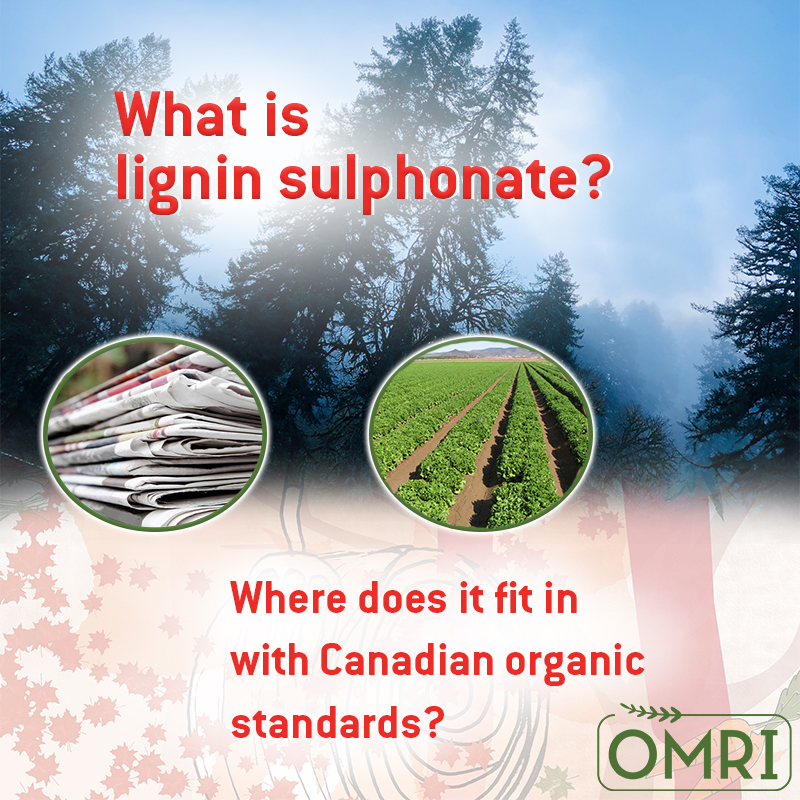Lignin Sulphonate
 When is lignin sulfonate allowed in organic production in Canada?
When is lignin sulfonate allowed in organic production in Canada?
By Everett Codd
Lignin sulphonates, also referred to as lignosulphonates or lignin sulphonic salts, are by-products of paper production. Wood, the base material from which most paper is made, is primarily composed of two types of materials: carbohydrates (such as cellulose and hemicellulose) and lignins. Lignins are molecularly complex and diverse, and difficult to break down. They are undesirable within most paper, so the lignin is extracted by cooking the woody material under pressure with sulphite chemicals. This process produces a liquor containing sulfonated lignin called lignosulphonate. The liquor is purified through fermentation, which produces alcohol that is removed. During these processes, the chemicals that are used can create various lignin sulphonic salts, such as sodium lignosulphonate, calcium lignosulphonate or magnesium lignosulphonate.
The Permitted Substances List (PSL) includes “Lignin and lignin sulphonates (ligno-sulphonates)” on Table 4.2 (columns 1 and 2) – Substances used for crop production, with the annotation:
Permitted as chelating agent(s), as formulant ingredient(s) and as dust suppressant(s). Ammonium lignosulphonate is prohibited. Other lignin forms such as lignosulphonic acid, calcium lignosulphonate, magnesium lignosulphonate, sodium lignin and sodium lignosulphonate are permitted.
While lignin sulphonates are identified as permitted substances, there are still questions regarding the forms that are allowed and how they are manufactured. The Standards Interpretation Committee (SIC) has responded to two questions about lignin sulphonate materials: Question 289 and Question 355. To summarize, the SIC has stated that ammonium lignin sulphonate (synonymous with ammonium lignosulphonate) is prohibited, but all other lignin sulphonates are allowed, including magnesium lignosulphate. The SIC has also stated that the substances used to manufacture lignin sulphonates are not restricted to those listed on the PSL.
Another similarly named substance, sodium lignin, is likely not considered synonymous with sodium lignosulphonate under Canada Organic Regime (COR) standards. Sodium lignin is also a wood byproduct, but instead of extracting lignin using sulphite chemicals under pressure, the lignin is extracted by heating the wood pulp under pressure in a sodium carbonate solution. The Standards Interpretation Committee has not addressed the sodium lignin issue specifically. However, OMRI has reviewed the material and does not consider sodium lignin to be synonymous with sodium lignosulphonate based on the manufacturing process.
Lignin sulphonate is restricted to use as a chelating agent, formulant ingredient or dust suppressant under the COR standards. Chelated micronutrients are widely used to meet nutrient deficiencies in crop production. Formulants may be used in conjunction with other substances found on the Permitted Substances Lists, and are commonly used in pesticides or fertilizers as inert materials. Dust suppressants are widely used across agriculture, fertilizer manufacturing and erosion control. Lignin sulphonate also has a large variety of uses outside the organic industry, including uses in the manufacture of concrete, plasterboard and tanning leather, as a deflocculating agent in linoleum flooring and coal briquettes, and as a fire retardant.
This article was originally published in the fall 2018 edition of the OMRI Materials Review newsletter, and was revised in December 2021 by Technical Director Doug Currier.








